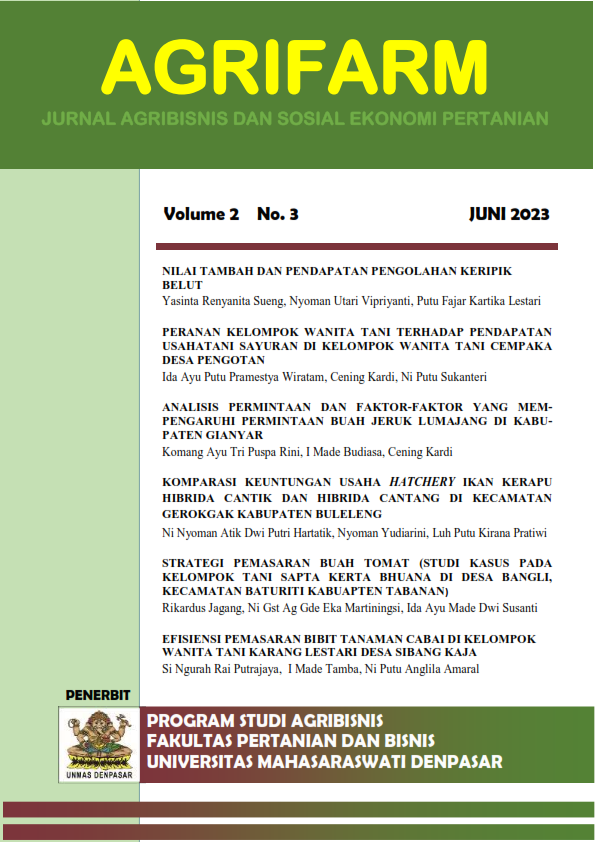KOMPARASI KEUNTUNGAN USAHA HATCHERY IKAN KERAPU HIBRIDA CANTIK DAN HIBRIDA CANTANG DI KECAMATAN GEROKGAK KABUPATEN BULELENG
Kata Kunci:
Comparison, Profit, Cantik Hybrid, Cantang HybridAbstrak
Compared to Cantik hybrid grouper seeds. However, the resistance to pathogen attack on the Cantang hybrid seeds was lower than that of the Cantik hybrid. Therefore, it is necessary to study the comparative profit of Cantang hybrid and Cantik hybrid grouper hatcheries. The aims of this study were to analyze the survival rate of the Cantik hybrid grouper and the Cantang hybrid grouper in Gerokgak District, and to analyze and test the comparison of the two hybrid grouper hatcheries. The method used was a survey of each of 12 sampels of hybrid hatcheries of Cantang and Cantik and analyzed the profit comparison of the two types of hatcheries using the two free sample test. The results showed that the average seed production of the Cantang hybrid grouper was 64,908 pieces with a survival rate of 12.89% from the number of eggs laid. The average seed production of Cantik hybrid grouper was 60,620 pieces with a survival rate of 12.38%. The profit of the Cantang hybrid grouper hatchery per production cycle is Rp. 54,813,226.00, while the profit of the Cantik hybrid grouper hatchery is Rp. 60,036,083.00. The difference between the profit of the grouper hatchery business of Cantik hybrid and Cantang hybrid is Rp. 5,222,857.00. However, this difference in profit is only significant at the test error rate of 0.20. From the results of this study, it is suggested to the hatchery business community to carry out joint management training in improving and pleasing hatchery workers. If grouper eggs for both types of hybrids are available, backyard farmers are advised to prioritize hatchery of Cantik hybrid groupers
Referensi
Badan Pusat Statistik. (2016). Statistik Daerah Kecamatan Gerokgak 2016. Buleleng: Badan Pusat Statistik Kabupaten Buleleng.
Dahuri, R. (2003). Keanekaragaman Hayati Laut: Aset Pembangunan Berkelanjutan Indonesia. Jakarta: PT. Gramedia Pustaka Utama.
Hanafi, M. Mamduh dan A. Halim. 2002. Analisis Laporan Keuangan. Edisi keempat. UPP STIM YKPN, Yogyakarta.
Ismi, S., dan N.A. Yasmina. 2011. Pengamatan Perkembangan Benih Kerapu Hibrid Hasil Persilangan antara Jantan Kerapu Kertang (Epinephelus lanceolatus) dengan Betina Kerapu Macan (E. fuscoguttatus). Prosiding Seminar Nasional Kelautan VII. Inspiring Sea for Live: Tantangan dalam Pengelolaan Sumberdaya Bijaksana dan Berkelanjutan.Universitas Hang Tuah. Hlm 81-100.
Ismi, S., Wardoyo, K.M. Setyawati, dan Trijoko. 2004. Pengaruh Frekuensi Pemberian Minyak Ikan pada Pemeliharaan Larva Kerapu Bebek (Cromileptis altivelis). J. Pen. Per. Indonesia, 10 (05): 61-65.
Ismi. S. 2014. Aplikasi Teknologi Pembenihan Kerapu Untuk Mendukung Pengembangan Budidaya Laut. Jurnnal IImu dan Teknologi Tropis. Vol. 6. (1): 109-119.
Johnny, Fris., D. Roza dan Zafran 2009. Efektifitas metode vaksinasi Flexibacter pada Benih Ikan Kerapu Macan, Epinephelus fuscoguttatus di Hacheri. Berita Biologi. 13 (2): 213-220.
Sitepu. (2008). Pengelolaan Sumberdaya Wilayah Pesisir dan Lautan Secara Terpadu. Jakarta: PT. Pradnya.
Soekartawi. 2011. Ilmu Usaha Tani. Universitas Indonesia: Jakarta.
Sugama, K., Tridjoko, B. Slamet, S. Ismi, E. Setiadi, dan S. Kawahara. 2001. Petunjuk teknis produksi benih ikan kerapu bebek, Cromileptes altivelis. Balai Riset Budidaya Laut Gondol. Pusat Riset dan Pengembangan Eksploirasi laut dan Perikanan Departemen Kelautan dan Perikanan dan Japan International Cooperation Agency.

